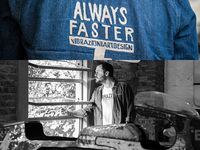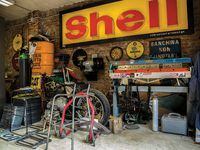A
ll is quiet and bucolic in the little orchard behind the old farmhouse in Massa Lombarda, 30 miles east of Bologna, until a yellow oil drum hurtling over a tall hedge announces Alberto Dassasso’s arrival. He appears after it, plowing through the brush with the physique and broad shoulders of a man who is, if not professionally engaged in beating order into metal, at least interested. Thick branches separate like water. Dassasso picks up the oil drum and continues toward the farmhouse, merrily hoisting the empty barrel at a vast pile of similarly colorful and rusted drums that age and acquire patina in a tangle of squash plants under the shade of an umbrella of fruit trees. This is Vibrazioni, and Dassasso one half of its motive force. The design shop has made a bustling business out of rendering discarded barrels into useful and beautiful things: furniture—chairs, tables, and cabinets, mostly—also, and spectacularly, motorcycle tanks and seats. One of their bikes sits in front of the doors of the little barn that serves as workshop and studio. It’s a brutal-looking Ducati Scrambler. All angles and colors. Beat-straight sections of oil drum are joined together, their iconic logos cut and reformed and reformed entirely out of context. It’s spectacular.
“It’s a kind of pop art,” Dassasso explains as he picks little fruit off a tree with dirty hands. They look like an olive and have the sweet taste and crunch of a red apple. “People see the barrels at a garage and think nothing of them. People see them as a chair and they notice the design and the color.”
The appropriation is eye-catching, no doubt. Giants of brand design were called upon to create the iconic oil company logos that Vibrazioni slices and shapes and welds. Raymond Loewy was responsible for Shell, Exxon, and BP. Tom Geismar for Mobil. It’s a Texaco and Shell motif for the Scrambler. The yellows and reds recall Ducati factory colors. The angles, the careful welds. The raw steel where plates join. Those are very much their own. An invention that recalls nothing at all.
Downstairs in the little barn is where the plasma cutter lives. The big grinders. A wicked-looking Chinese lathe and dozens of hammers. So many hammers. Busted car speakers act as fridge magnets and tack sketches to big industrial gas bottles. A yellowed newspaper clipping of Marco Simoncelli hangs on the rough brick wall next to pretty little pieces of brake caliper and fuel tank and the big black valve covers of a Moto Morini.
“Do you like Morini?” Dassasso asks. He wheels a Corsaro out of a shed and starts it. They’re lovely machines with a clean tone. Its big V is mesmerizing. He raps the throttle enthusiastically but with the mechanical sympathy of a man who’d be repairing the rare machine himself if he rapped uncautiously.
Dassasso climbs a steep set of stairs into the loft for espresso. That’s the design studio. An execution of the same feeling downstairs writ through intellect rather than muscle and heat. The old wood floor is painted white and it’s dotted with prototypes and desks and humming computers. Illustrations and schematics paper every surface. The organization is haphazard convenient. Clean but not tidy. Morning light filters through the windows and it’s almost perfect. Dassasso’s design partner Riccardo Zanobini arrives from Bologna and ascends the stairs. He leans into the window to light a cigarette. Then the light is perfect, filtering warmly through the thin haze.
Nominally Vibrazioni is a manufacturer of things. And they are. Cabinets and kitchen tables and custom motorcycles—but also of a feeling. One captured in beat old metal and the smell of cooking espresso and ozone. One unique to this little sliver of Italy and one that’s appealing anywhere.














/cloudfront-us-east-1.images.arcpublishing.com/octane/REWQEGZGG3NZEN4EFSSENU3VBM.jpg)



/cloudfront-us-east-1.images.arcpublishing.com/octane/VZZXJQ6U3FESFPZCBVXKFSUG4A.jpg)
/cloudfront-us-east-1.images.arcpublishing.com/octane/QCZEPHQAMRHZPLHTDJBIJVWL3M.jpg)
/cloudfront-us-east-1.images.arcpublishing.com/octane/HXOUJXQWA5HBHGRO3EMJIGFMVI.jpg)

/cloudfront-us-east-1.images.arcpublishing.com/octane/3TIWWRV4JBBOLDVGRYECVVTA7Y.jpg)
/cloudfront-us-east-1.images.arcpublishing.com/octane/KIX5O23D5NAIBGFXBN3327DKZU.jpg)
/cloudfront-us-east-1.images.arcpublishing.com/octane/7GJYDUIPXRGMTMQKN6ONYOLBOU.jpg)
/cloudfront-us-east-1.images.arcpublishing.com/octane/MUQLOVLL2ZDGFH25ILABNBXKTI.jpg)
/cloudfront-us-east-1.images.arcpublishing.com/octane/TNOU5DNE2BC57MFPMGN2EIDXAM.jpg)
/cloudfront-us-east-1.images.arcpublishing.com/octane/GTCXACQGJ5HAPDTGWUQKDEH44E.jpg)
/cloudfront-us-east-1.images.arcpublishing.com/octane/S35YGSEMEZB4BLTDJTSZPF4GLA.jpg)
/cloudfront-us-east-1.images.arcpublishing.com/octane/5UOT6HPX2JFMRJAX6EH45AR4MQ.jpg)
/cloudfront-us-east-1.images.arcpublishing.com/octane/OKWOJWAKP5EP3OACCRRWPCIX2Q.jpg)
/cloudfront-us-east-1.images.arcpublishing.com/octane/2WF3SCE3NFBQXLDNJM7KMXA45E.jpg)
/cloudfront-us-east-1.images.arcpublishing.com/octane/G4MG6OUCJNBSHIS2MVVOTPX65E.jpg)
/cloudfront-us-east-1.images.arcpublishing.com/octane/IIGGWFOTOJGB7DB6DGBXCCMTDY.jpg)
/cloudfront-us-east-1.images.arcpublishing.com/octane/QSTCM6AVEZA5JJBUXNIQ3DSOF4.jpg)
/cloudfront-us-east-1.images.arcpublishing.com/octane/U4I7G625B5DMLF2DVIJDFZVV6M.jpg)
/cloudfront-us-east-1.images.arcpublishing.com/octane/B6XD6LS6IVCQPIU6HXDJSM3FHY.jpg)
/cloudfront-us-east-1.images.arcpublishing.com/octane/ICL63FEDDRDTTMINYICCEYGMDA.jpg)
/cloudfront-us-east-1.images.arcpublishing.com/octane/FCGZHQXRBZFLBAPC5SDIQLVF4I.jpg)
/cloudfront-us-east-1.images.arcpublishing.com/octane/WNOB6LDOIFFHJKPSVIWDYUGOPM.jpg)

/cloudfront-us-east-1.images.arcpublishing.com/octane/X33NU3E525ECRHXLNUJN2FTRKI.jpg)